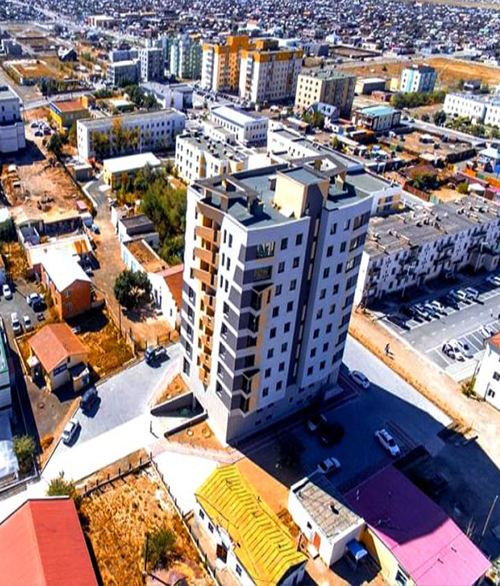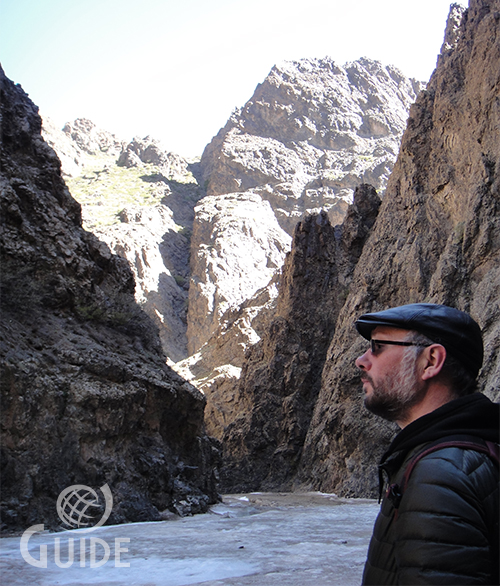Itinerary
DAY 1: Chinggis Khaan Airport - UB (55 km)
We welcome you to Mongolia at Chinggis Khaan Airport and our team will transfer you to a hotel. Depending on your arrival time, you will be offered to take a city tour.
Meal: Dinner
Accommodation: Hotel
DAY 2: Dalanzadgad – Yoliin am valley (Domestic flight 560 km, drive 60 km)
Early morning, you will take a domestic flight to Dalanzadgad, provincial capital of Umnugovi (South Gobi province). The Yoliin am of the Gobi Gurvan Saikhan mountain (Gobi Three beauty mountain) is one of the best destinations for international birdwatchers and tourists. In the Yoliin am, there is a "roosting place" for large predatory birds, such as Lammergeier, Cinereous Vulture, Himalayan Vulture, Golden Eagle, which show up for overnight and leave for hunting in the morning. There you can see all the predatory birds of Gobi Desert. As well as, you are able to see birds that attract the bird lovers such as Altai snow cock, Mongolian Accentor, Wallcreeper, Beautiful Rosefinch, Saker Falcon, Small Snowfinch, Red-mantled Rosefinch, Common Rosefinch, Mongolian Finch. Yoliin am is a major base place for the study of animals, flora and birds of the Gobi Desert.
Meal: Breakfast, Lunch, Dinner
Accommodation: Tourist camp
DAY 3: Ulaan Khuree (140 km)
We will travel to Alashan Plateau semi-desert terrain, the 16th area of Mongolia's flora and geography region. There, you will focus to watch one of the most interesting and rare 12 species of Jerboa, which is listed as animals to see in Mongolia for foreign mammal lovers and researchers. Besides Long eared Jerboa, you can see Kozlov’s Pygmy Jerboa, Thick-tailed Pygmy Jerboa, Five-toed Pygmy Jerboa, Balikun Jerboa, Gobi Jerboa, as well as the Marbled Polecat, Steppe Polecat.
Meal: Breakfast, Lunch, Dinner
Accommodation: Camping in a tent
DAY 4: Baruun Zuun Bugtii (West and East Bugtii) – Khongor sand dunes (240 km)
Khongor sand dune is not only one of the largest sand dunes in Mongolia but also the must-see destination for tourists visiting the Mongolian Gobi. However, Gobi Desert and its sand dunes are similar by climate to the world-famous Arizona and Sahara deserts, it varies by its unique wildlife features. The difference is that it is a home to various species of animals and birds, as well as numerous plants and trees grow there. If you take a night trip to the Khongor sands, you can spot rare and important Mongolian animals including small mammals such as Kozlov’s Pygmy Jerboa, Thick-tailed Pygmy Jerboa, Desert Hamster, Campbell’s Hamster, Mongolian Hamster, Eurasian Badger, Corsac Fox. Around there, you can also see Saxaul Sparrow, Mongolian Ground Jay, which are registered in the "Red book" of Mongolia, as long as one of the common but interesting birds that attract the attention of foreign and domestic bird lovers, tourists and researchers, Pallas’ Sandgrouse, Asian Desert Warbler.
Meal: Breakfast, Lunch, Dinner
Accommodation: Tourist camp
DAY 5: Dalanzadgad 250 km
This day we drive to east from the Khongor sand dunes passing through Dalanzadgad and arrive at Bulagtain steppe. There, you will see the beautiful Oriental Plover, which ranks top of the must-see list of tourists and birders coming to Mongolia. You will observe the birds in Dalanzadgad’s gardens, in tree breeding stations, and in nearby springs. There you also can spot small birds of the Gobi, some species of owl and Boreal owl, falcon, and certain small predatory birds. Dalanzadgad has a special meaning for its name. “Dalan” (Seventy) means 70 or "numerous" and "zadgad" means "open". A few years ago, this name originated from the fact that there were many open springs and water flows around. The bird gatherings in those small basins of water gives bird watchers a great opportunity to discover more about the birds. Since water is very scarce in the Gobi Desert, so small rodents, Gobi mammals, camels, and Gobi nomads drink from the small springs that could be found around to quench their thirst.
Meal: Breakfast, Lunch, Dinner
Accommodation: Tourist camp
DAY 6: Gun Galuutai (560 km by domestic flight & 130 km by car)
You will depart by domestic flight to Ulaanbaatar and arrive at Chinggis Khaan airport. Then we head to Gun Galuutai, 130km east from the airport. This place, where we can see wetland birds, offers heaven to birds with its beautiful landscape assembled with small lakes, river Kherlen, and surrounding rocky mountains. The Kherlen river, which is the second largest in Mongolia, flows through its east side, and there are many small lakes in its west and northwest. Black storks, cranes, and egrets are common here. You will lodge in a nearby tourist camp and spot the birds at your own pace. Ornithologists have identified more than 100 species of birds in the wetlands of this region. For being such rich habitat, the region has been protected by the local herder families and the number of livestock flocks has been limited and kept small in this important birding place.
Meal: Breakfast, Lunch, Dinner
Accommodation: Tourist camp
DAY 7: Onon - Khurkh (300 km)
This day we travel to Onon and Khurkh rivers in Khentii province region. Onon - Khurkh basin and its river thickets offers appropriate home to many species of field small birds, as well as 6 species of cranes settle down throughout summers. This eastern branch of the Khenti mountain range is a place with beautiful nature of the forest and steppe valleys filled with more than 30 streams and 20 small lakes. These streams and lakes host real “birds gathering” and numerous species of birds come to roost around it. One of the very few places in the world where you can see 5 species of cranes at the same time is the valley of the Onon-Khurkh rivers. Study has shown that their population was increased in the area in recent years, so researchers and conservationists have named it the "Crane Village" of Mongolia.
Meal: Breakfast, Lunch, Dinner
Accommodation: Tourist camp
DAY 8: Onon – Khurkh river valley (70 km)
This day, you will continue bird spotting in the Onon-Khurkh basin. We travel through Tsagaan lake of Onon river valley, Pine Forest Garden, and Yargui gorge. Lakes and wetland of the Khurkh and Khuiten river valley are located in the northeastern Mongolia and consist of two parts. The part of the Khurkh river valley is called Part A and covers an area of 26,650 hectares. This valley features of being in the frost distribution belt of Mongolia. The most suitable habitat for water-birds is permafrost lakes, which are particularly vulnerable to climate change. 54 species of mammals and 167 species of birds have been recorded in the lakes and wetlands of those valleys. While 26 species of birds permanently reside, other 141 species are migratory birds.
Meal: Breakfast, Lunch, Dinner
Accommodation: Tourist camp
DAY 9: Ugtam mountain (300 km)
Early morning, we depart from Khentii province to Dornod (Eastern) province region. You make observation in the Ulz River valley, the steppe area with small lakes, broadleaved forests, and mountain meadows. In this environment, about 250 species of birds have been recorded. We stop by Ugtam mountain and Ulaan ereg on the way to reach at Chukh lake and stay in a tourist camp.
As the summer of 2019, it was estimated that about 19,100 birds of 141 species settled in the vicinity of the lake. It is a lake with an elongated shape stretching from the south to the north, surrounded by low hills on the left and right sides, with low sand dunes slopes in its north and south side. There, we find an "observation point" for bird watchers. In recent years, Chukh Lake has become one of the favorite destinations for professional ornithologists, and its species and population of birds have been increased year by year. Many bird conservation projects are also implemented there.
Meal: Breakfast, Lunch, Dinner
Accommodation: Tourist camp
DAY 10: Mongol Daguur - Yakhi Lake – Choibalsan (280 km)
We we’ll spot birds in the strictly protected area of Mongol Daguur. It is the northeastern region of Mongolia, and its humid steppes, large and small lakes, ponds, streams, and wetlands serve as a resting place for birds migrating from Southeast Asia to the Arctic Ocean. This place is distincive for being a breeding ground for many tropical species, aquatic birds, and shorebirds. Mongol Daguur strictly protected area borders with Daursky natural reserve in the territory of the Russian Federation. The area is included among the 200 ecoregions that have been declared as distinct assemblages of natural communities and species that must be protected worldwide. As there are undulating low mountains, plains, diverse lakes, and hollows, the region offers favorable gathering place to cranes, bustards, swans, various species of ducks, and shore birds. In the afternoon, we arrive at Yakhi Lake and there you can find around 17 small salt lakes. Among of them, Yakhi lake is the biggest. To this lake, Galiin River streams and the level of the lake changes depending on the rainfall and runoff streams. In autumn, the Galiin River dries up and so that Yakhi Lake often turns into muddy soil. The lake is the northern edge of the antelope flocks’ habitat distribution. Before dinner, we will arrive at Choibalsan, the provincial capital of the eastern province of Mongolia, and stay at a hotel and relieve the fatigue of the journey.
Meal: Breakfast, Lunch, Dinner
Accommodation: Tourist camp
DAY 11: Gamal Mountain (340 km)
On this day, we will drive on back route to UB city. Passing through Chinggis, the provincial of Khentii, and arrive and stay at the tourist camp in the foot of Gamal Mountain. Gamal Mountain is a majestic high rocky hilled mountain and is said to have been named after Gamal, the grandson of Kublai Khan. There you can see grazing wild sheep from close distance. We observe through the surrounding mountains.
Meal: Breakfast, Lunch, Dinner
Accommodation: Tourist camp
DAY 12: Ulaanbaatar (340 km)
After early breakfast, you depart to Ulaanbaatar. In Ulaanbaatar, following the lunch, you’ll arrive to the hotel. You can take rest for 2-3 hours and relieve bit from the tiredness of the long journey. During the dinner, we watch a performance of traditional song and dance. Then you will stop by souvenir shops and cashmere boutiques and return to the hotel. Tourists coming to Mongolia almost never leave without listening the traditional music of the horse-headed fiddle, Mongolian throat singing, and folk long song. When you listen to the melody of the horse fiddle, the sound of the long song, and the eccentric sound of throat singing, you’ll grasp more about all the colors of the people’s life and nature of Mongolia and their customs, joy, vast plains, snow-covered peaks, mountains, forests, etc., If you this is your first time to Mongolia, it would be a good idea to buy handicrafts and useful stuffs that remind you about the country and trip.
Meal: Breakfast, Lunch, Dinner
Accommodation: Hotel
DAY 13: Chinggis Khaan Airport (55 km)
We will transfer you to the airport according to your departure time from Chinggis Khaan International Airport.
Meal: Breakfast









